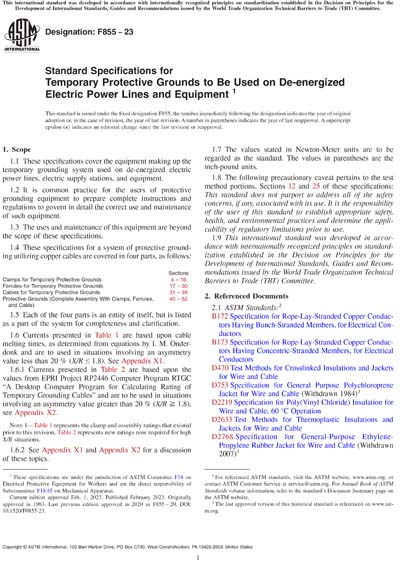Most recent
ASTM F855-23
Standard Specifications for Temporary Protective Grounds to Be Used on De-energized Electric Power Lines and Equipment
1.1These specifications cover the equipment making up the temporary grounding system used on de-energized electric power lines, electric supply stations, and equipment.
1.2It is common practice for the users of protective grounding equipment to prepare complete instructions and regulations to govern in detail the correct use and maintenance of such equipment.
1.3The uses and maintenance of this equipment are beyond the scope of these specifications.
1.4These specifications for a system of protective grounding utilizing copper cables are covered in four parts, as follows:
1.5Each of the four parts is an entity of itself, but is listed as a part of the system for completeness and clarification.
1.6Currents presented in Table 1 are based upon cable melting times, as determined from equations by I. M. Onderdonk and are to used in situations involving an asymmetry value less than 20 % (X/R ‰¤ 1.8). See Appendix X1.
Note 1:TPG testing is done on complete assemblies. Assembly ratings assume the grade of lowest graded component (see 43.1.6).
1.6.1Currents presented in Table 2 are based upon the values from EPRI Project RP2446 Computer Program RTGC "A Desktop Computer Program for Calculating Rating of Temporary Grounding Cables" and are to be used in situations involving an asymmetry value greater than 20 % (X/R ‰§ 1.8), see Appendix X2.
Note 1:The above current values are based on electromechanical test values.
Note 2:Assemblies that have been subjected to these shall not be re-used.
Note 3:For use with currents exceeding 20 % asymmetry factor.
Note 4:See X2.7.2 for additional information.
Note 5:Alternate testing circuits are available for laboratories that cannot achieve the above requirements. See Appendix X2 for details.
Note 1:Table 1 represents the clamp and assembly ratings that existed prior to this revision. Table 2 represents new ratings now required for high X/R situations.
1.6.2See Appendix X1 and Appendix X2 for a discussion of these topics.
1.7The values stated in Newton-Meter units are to be regarded as the standard. The values in parentheses are the inch-pound units.
1.8The following precautionary caveat pertains to the test method portions, Sections 12 and 25 of these specifications: This standard does not purport to address all of the safety concerns, if any, associated with its use. It is the responsibility of the user of this standard to establish appropriate safety, health, and environmental practices and determine the applicability of regulatory limitations prior to use.
1.9This international standard was developed in accordance with internationally recognized principles on standardization established in the Decision on Principles for the Development of International Standards, Guides and Recommendations issued by the World Trade Organization Technical Barriers to Trade (TBT) Committee.
ASTM International [astm]

